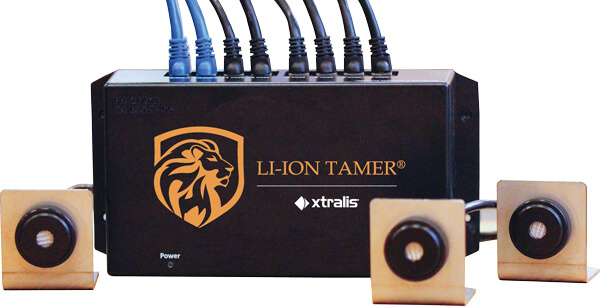
Over the past decade, computer room backup power has transitioned from reliance on lead-acid batteries to lithium-ion batteries. In the past, it was common to have a separate battery room filled with lead-acid batteries. Today the server backup-power is provided by lithium-ion batteries, which are installed in the server racks. These lithium-ion batteries are the backup in the event power from the grid is interrupted (e.g., power failure). This preferred battery technology is specifically designed to fit standard server racks. Suppose the main source of power is lost. In that case, the computers are automatically switched over (almost instantaneously) to lithium-ion batteries, which provide uninterrupted power supply (UPS) to critical equipment, including computer servers, storage devices, and networking equipment. The batteries are an essential component of the server room infrastructure to ensure business continuity. They are considered as critical as the climate control equipment used to cool the computer equipment. But most rack servers are not adequately protected from business interruption or data loss that can occur with a thermal-runaway fire of lithium-ion batteries.
Recent Fire History
Although your customers understand the importance of maintaining UPS and climate control, they probably don’t understand how important it is to prevent thermal runaway of their lithium-ion batteries. They may be lulled into a false sense of security, thinking the building’s automatic sprinkler system solves the fire problem. The reality is that the sprinklers might control a rack server fire and keep the fire from spreading beyond the rack(s) of fire origin, as was the case with the Digital Realty data center fire in El Segundo, California, on Sunday, May 21, 20231. Although the sprinkler system limited the damage from heat from the fire, the impact of the loss was substantial. According to an online article on data center fires, “… these incidents can cost data center operators anywhere from $250,000 to over $500,000 per hour of outage”2.
Fire Sprinklers have Limitations.
Since sprinklers will only limit fire damage, the objective with lithium-ion batteries should be to prevent these fires altogether. That is where the Xtralis Li-Ion Tamer rack monitor comes into play. This Xtralis system detects the venting of battery electrolyte vapors (off-gassing phase) that occurs during the early failure mode of a lithium-ion battery. Early detection allows mitigation prior to thermal runaway and a catastrophic battery fire.

Li-Ion Tamer Group
Early Warning and Mitigation
The Li-ion Tamer Rack Monitoring system, is plug-and-play technology. It is easy to install by knowledgeable low-voltage technicians qualified to install fire detection systems in buildings.
Here is an overview of the off-gas sensors used in the Xtralis Li-Ion Tamer:
- Sensors are installed at each battery rack.
- Sensors are acutely sensitive to lithium-ion battery electrolyte vapors.
- Sensors monitor off-gassing prior to a fire event.
- Sensors do not require calibration.
- Sensors are compatible with all forms of lithium-ion batteries.
- Sensors have a lifetime comparable to a typical lithium-ion battery system.
- Sensors identify when and where off-gassing is occurring prior to a fire event.
- Sensors are connected to the controller that contains proprietary logic.
Ease of Operation and Low Maintenance
The Xtralis Li-ion Tamer rack monitor is operational once installed and requires minimal maintenance since the sensors are calibration-free and have a comparable lifetime to that of the lithium-ion battery system. Sensor response is easily verified with a bump test. To confirm operation, sensors are activated with a bottle of battery off-gassing material (diethyl carbonate) available from Brooks.
Fire Safety Strategy
It is important to stress to your customers that this system does not prevent fires or thermal runaway. It is an early-warning system that is not stand-alone and needs to be integrated with the overall fire prevention and fire safety strategy. The important thing to stress is that when the system responds, a risk of battery fault has been identified, which could lead to thermal runaway and fire. There is time for intervention (shutdown and battery removal). That is because there will be several minutes between early detection and the time it takes for the problem cell(s) to generate sufficient heat to cause fire. The time varies from just a few minutes to 30 minutes or more, depending on battery types, configuration, and cause of the thermal runaway. To avoid injury, most personnel need to leave the area immediately and follow the company’s written fire plan.
Business Expansion Opportunities
There are thousands of server rack rooms without the safety of Xtralis Li-Ion Tamer rack monitors. Inform your customers that you have the solution that allows intervention before lithium-ion battery thermal runaway and before a fire breaks out. Notification and intervention allows your customers to maintain business continuity and remain profitable.
Safety and preventing data loss and business interruption from a devastating fire are the objectives. Installing the Xtralis Li-Ion Tamer has the potential to save your customers millions of dollars where lithium-ion batteries threaten their data and business continuity.
1Fire Hits Digital Realty Facility in El Segundo, California, Two colo halls closed by the fire department after a blaze in the racks, Peter Judge, May 25, 2023, https://www.datacenterdynamics.com/en/news/fire-hits-digital-realty-facility-in-el-segundo-california/.
2Data Center Fires: A Detailed Breakdown with 19 Examples, Mary Zhang, May 25, 2023, https://dgtlinfra.com/data-center-fires/.